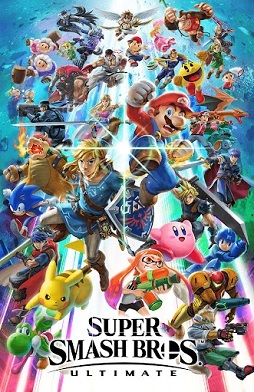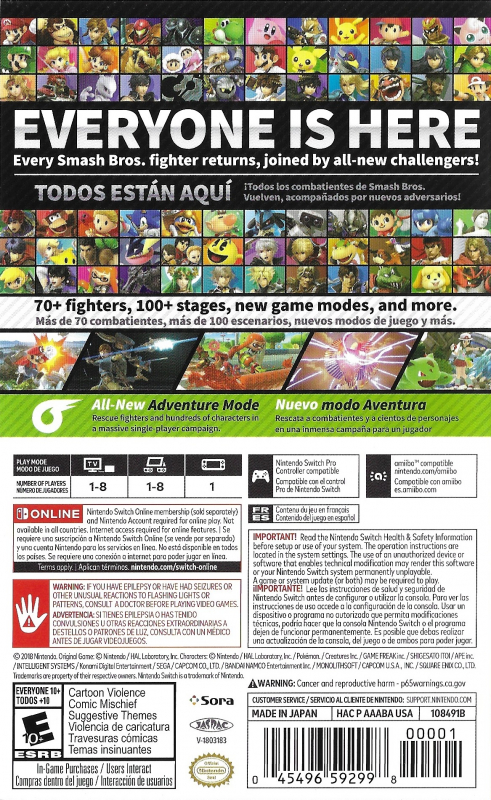Existing User Log In
New User Registration
Register for a free account to gain full access to the VGChartz Network and join our thriving community.





America - Front


America - Back

There's no greater celebration of video game history than Super Smash Bros. Ultimate. Featuring characters, stages, and items inspired by legendary companies like Nintendo, Capcom, Konami, Sega, Namco, Ubisoft, and Tecmo, it's as much a virtual museum as it is a polished, addictive, absolutely mammoth, mechanically-irreproachable fighting game. Indeed, when Ultimate's encyclopedic knowledge of Nintendo and other industry giants combines with its peerless platform-brawling and extensive suite of single player and multiplayer modes, it creates arguably the best installment of the long-running mascot fighter and, ultimately, one of the better games of the generation.
Since the GameCube days Nintendo has poured a lot of care and attention into the Smash Bros. series, but with Ultimate the company has gone above and beyond. With 74 playable characters (76 if you include Pokemon Trainer's monsters as individual combatants), 103 stages, a "classic" single-player mode, local multiplayer for up to eight, online arenas, tournament and special battle options, and a substantial Spirits mode—alone worth the price of admission—Ultimate is one of the most feature-rich and replayable games the Kyoto-based company has ever launched.

Ultimate is divided up into five main branches: Smash, Spirits, Games & More, Online, and Vault. Smash is the foundation of the game. Featuring completely customizable battles with up to eight fighters, it's here where many players will log their longest sessions. Start by creating a custom ruleset—time or stock, final smash meter, spirits, CPU level, handicaps, items, etc.—then choose from scores of stages; select one of dozens of songs unique to each stage; and finally pick your favorite of 74 fighters, each with eight color schemes.
All of these options are inessential, though, compared to Ultimate's heavenly fighting mechanics. This is easily the smoothest, snappiest, fastest—if it's not technically faster than Melee it's darn close, with run speeds increased by 10 percent for the majority of the roster—incarnation of Smash Bros. Never before have the characters' on-screen blows, jumps, and dodges felt more like an extension of the player. This is true for the old guard and the new kids on the block, some of whom—Inkling, Simon Belmont, and King K. Rool—are among the most interesting and powerful in the entire game.

While Ultimate's roster of newcomers comes in at a respectable 11, its collection of brand new stages is less impressive. There are seven in total, but three—Battlefield, Big Battlefield, and Final Destination—are variations on a long-running theme. Still, it's hard to complain about 100-plus stages, especially when each one boasts a Battlefield and Omega variant.
Spirits, the largest and most notable addition in Ultimate, doubles as an epic single player adventure and a perk-collecting macro-game. The adventure, deemed World of Light, takes place in a stylized, colorful overworld after a cataclysmic event. Players will explore the ruined world, submit to challenges both easy and near-impossible, awaken famous video game characters, and collect over one thousand spirits—drawn from the annals of video game history—which grant various buffs and debuffs. World of Light is a masterstroke in itself, offering up 15-20 hours (more if you want 100 percent) of single player strategy and action.

While World of Light in particular and Spirits mode in general are amazingly deep and often addictive, sometimes they can be—like Ultimate itself—overwhelming. You'll need to manage your party, which consists of fighters, primary spirits like Bomberman and Venusaur—each with unique stats, slots, and traits—and support spirits. You can manage these spirits by leveling them up, dismissing them to retrieve powerful spirit cores, and parlaying those cores into new, more powerful spirits. What's more, you can actually send your spirits off to mine for items or train in dojos littered across the World of Light. The minutiae of it all can be overpowering.
Inside Games & More, you'll find Classic mode, where each fighter sets off on a unique adventure. Here you pick your champion, set the Intensity—the higher the number the stronger the enemies and greater the rewards—and play through a campaign that's tailored to each character, in terms of stages, bosses, and rules. Donkey Kong's adventure, for example, features Diddy Kong as an AI teammate, just as in the original Donkey Kong Country. Link's adventure, meanwhile, culminates in a battle with the hulking, beastly form of the Demon King, Ganon.

Online is where you'll battle for bragging rights with players around the world, or simply watch heated battles from the stands. To jump most easily into a match, pick Quickplay. If you set preferred rules to On, the game will attempt—and attempt really is the most suitable word—to match you with like-minded players. While preferred rules were famously ignored early in Ultimate's career, with version 1.2 in effect, those preferences are now more highly prioritized. If you'd rather leave luck to heaven, however, you can create an arena with rules of your choosing and invite friends.
Finally, Vault is the repository of songs—around 850 of them—replays, tips, records, and challenges. Here you can check your progress, play time, and benchmarks, and even create a playlist of your favorite video game songs to take into battle.

In terms of mechanics and modes, Ultimate is a masterpiece, but audio-visually it's no slouch. The collection of classic and remixed tunes is exceptional, punch and kick effects are loud and impactful—which adds to the snappy, forceful feeling of the game—and visual flairs like smoke trails, confetti bursts, zooms, and particle effects make each battle more alive and dynamic. That said, while everything looks great mid-skirmish, end-of-match portraits and other close-up shots reveal some undistinguished texture and model work.
Super Smash Bros. Ultimate arrived with a promise, embedded in its title. It's now safe to say Masahiro Sakurai and company have crafted the ultimate incarnation of the world's best platform brawler. As much an homage to the video game industry as it is a finely-tuned, polished, hugely replayable fighter, Ultimate is a terrific option for fighting fans, local multiplayer partiers, online braggarts, and students of gaming history. A lack of new stages and some overwhelming tactical and strategic options in Spirits notwithstanding, it's among the best games of the last five years.









